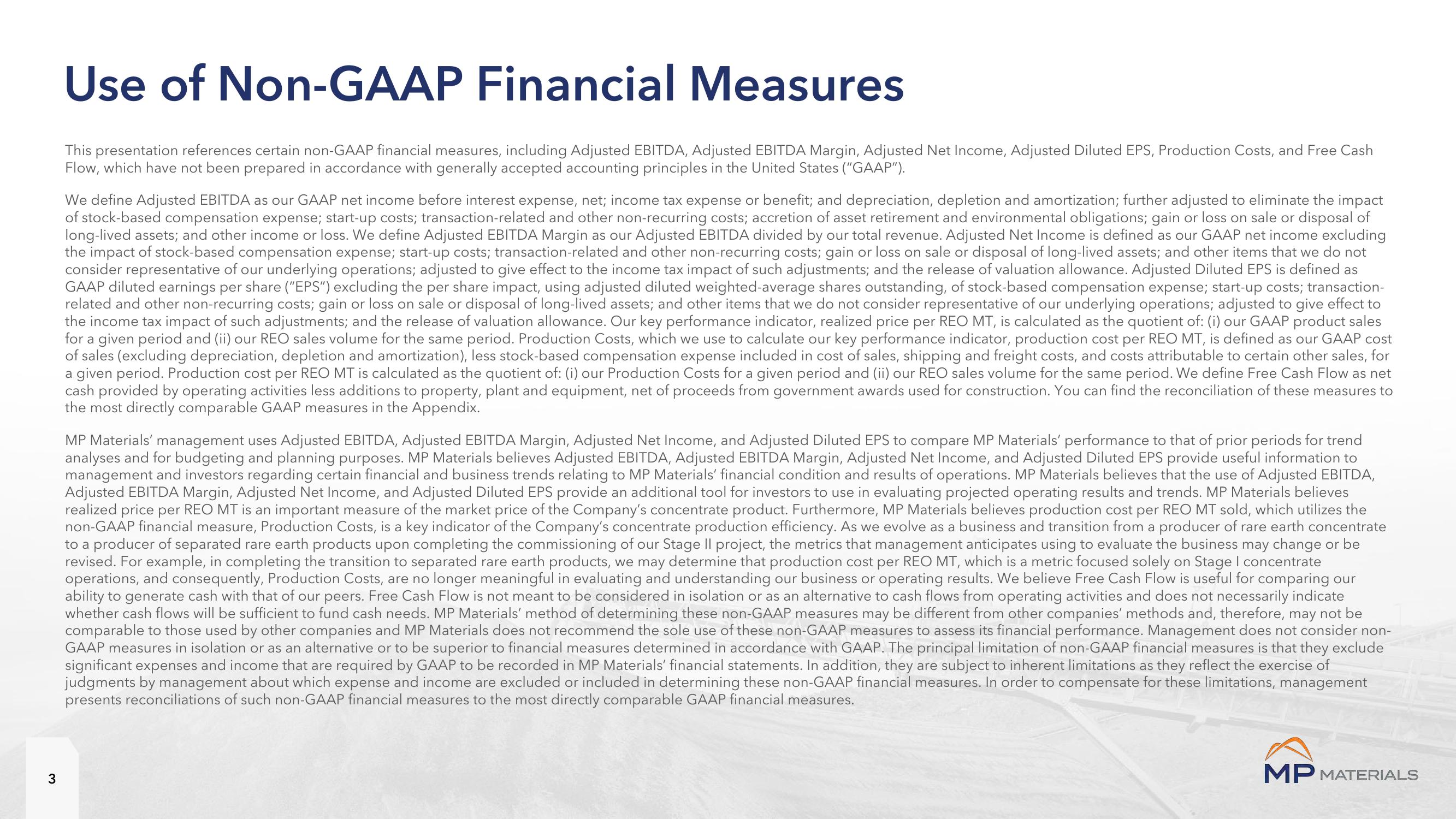MP Materials Results Presentation Deck
3
Use of Non-GAAP Financial Measures
This presentation references certain non-GAAP financial measures, including Adjusted EBITDA, Adjusted EBITDA Margin, Adjusted Net Income, Adjusted Diluted EPS, Production Costs, and Free Cash
Flow, which have not been prepared in accordance with generally accepted accounting principles in the United States ("GAAP").
We define Adjusted EBITDA as our GAAP net income before interest expense, net; income tax expense or benefit; and depreciation, depletion and amortization; further adjusted to eliminate the impact
of stock-based compensation expense; start-up costs; transaction-related and other non-recurring costs; accretion of asset retirement and environmental obligations; gain or loss on sale or disposal of
long-lived assets; and other income or loss. We define Adjusted EBITDA Margin as our Adjusted EBITDA divided by our total revenue. Adjusted Net Income is defined as our GAAP net income excluding
the impact of stock-based compensation expense; start-up costs; transaction-related and other non-recurring costs; gain or loss on sale disposal of long-lived assets; and other items that we do not
consider representative of our underlying operations; adjusted to give effect to the income tax impact of such adjustments; and the release of valuation allowance. Adjusted Diluted EPS is defined as
GAAP diluted earnings per share ("EPS") excluding the per share impact, using adjusted diluted weighted-average shares outstanding, of stock-based compensation expense; start-up costs; transaction-
related and other non-recurring costs; gain or loss on sale or disposal of long-lived assets; and other items that we do not consider representative of our underlying operations; adjusted to give effect to
the income tax impact of such adjustments; and the release of valuation allowance. Our key performance indicator, realized price per REO MT, is calculated as the quotient of: (i) our GAAP product sales
for a given period and (ii) our REO sales volume for the same period. Production Costs, which we use to calculate our key performance indicator, production cost per REO MT, is defined as our GAAP cost
of sales (excluding depreciation, depletion and amortization), less stock-based compensation expense included in cost of sales, shipping and freight costs, and costs attributable to certain other sales, for
a given period. Production cost per REO MT is calculated as the quotient of: (i) our Production Costs for a given period and (ii) our REO sales volume for the same period. We define Free Cash Flow as net
cash provided by operating activities less additions to property, plant and equipment, net of proceeds from government awards used for construction. You can find the reconciliation of these measures to
the most directly comparable GAAP measures in the Appendix.
MP Materials' management uses Adjusted EBITDA, Adjusted EBITDA Margin, Adjusted Net Income, and Adjusted Diluted EPS to compare MP Materials' performance to that of prior periods for trend
analyses and for budgeting and planning purposes. MP Materials believes Adjusted EBITDA, Adjusted EBITDA Margin, Adjusted Net Income, and Adjusted Diluted EPS provide useful information to
management and investors regarding certain financial and business trends relating to MP Materials' financial condition and results of operations. MP Materials believes that the use of Adjusted EBITDA,
Adjusted EBITDA Margin, Adjusted Net Income, and Adjusted Diluted EPS provide an additional tool for investors to use in evaluating projected operating results and trends. MP Materials believes
realized price per REO MT is an important measure of the market price of the Company's concentrate product. Furthermore, MP Materials believes production cost per REO MT sold, which utilizes the
non-GAAP financial measure, Production Costs, is a key indicator of the Company's concentrate production efficiency. As we evolve as a business and transition from a producer of rare earth concentrate
to a producer of separated rare earth products upon completing the commissioning of our Stage II project, the metrics that management anticipates using to evaluate the business may change or be
revised. For example, in completing the transition to separated rare earth products, we may determine that production cost per REO MT, which is a metric focused solely on Stage I concentrate
operations, and consequently, Production Costs, are no longer meaningful in evaluating and understanding our business or operating results. We believe Free Cash Flow is useful for comparing our
ability to generate cash with that of our peers. Free Cash Flow is not meant to be considered in isolation or as an alternative to cash flows from operating activities and does not necessarily indicate
whether cash flows will be sufficient to fund cash needs. MP Materials' method of determining these non-GAAP measures may be different from other companies' methods and, therefore, may not be
comparable to those used by other companies and MP Materials does not recommend the sole use of these non-GAAP measures to assess its financial performance. Management does not consider non-
GAAP measures in isolation or as an alternative or to be superior to financial measures determined in accordance with GAAP. The principal limitation of non-GAAP financial measures is that they exclude
significant expenses and income that are required by GAAP to be recorded in MP Materials' financial statements. In addition, they are subject to inherent limitations as they reflect the exercise of
judgments by management about which expense and income are excluded or included in determining these non-GAAP financial measures. In order to compensate for these limitations, management
presents reconciliations of such non-GAAP financial measures to the most directly comparable GAAP financial measures.
MP MATERIALSView entire presentation